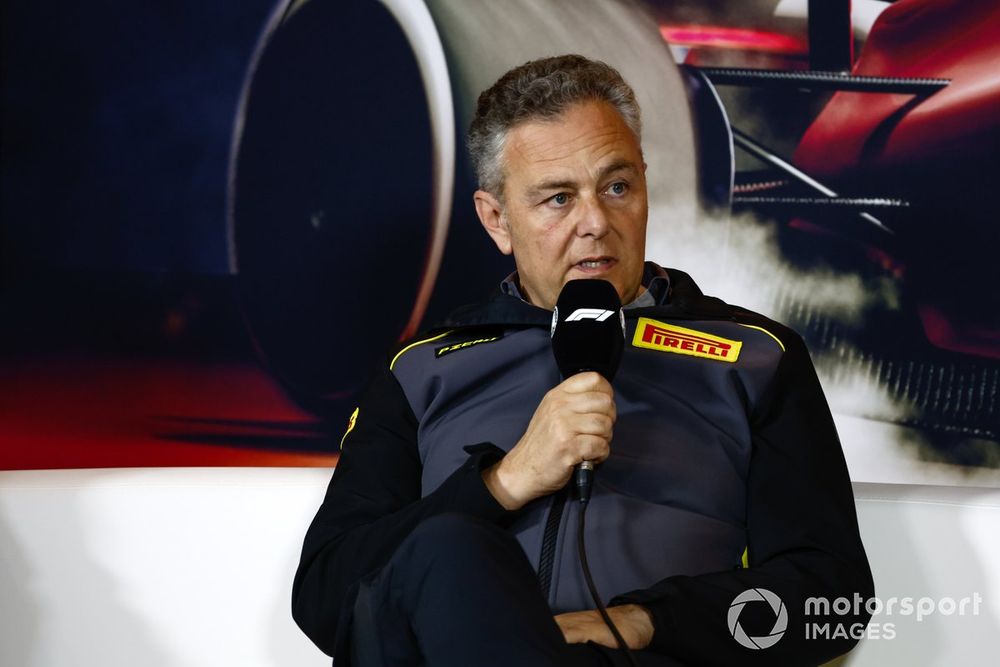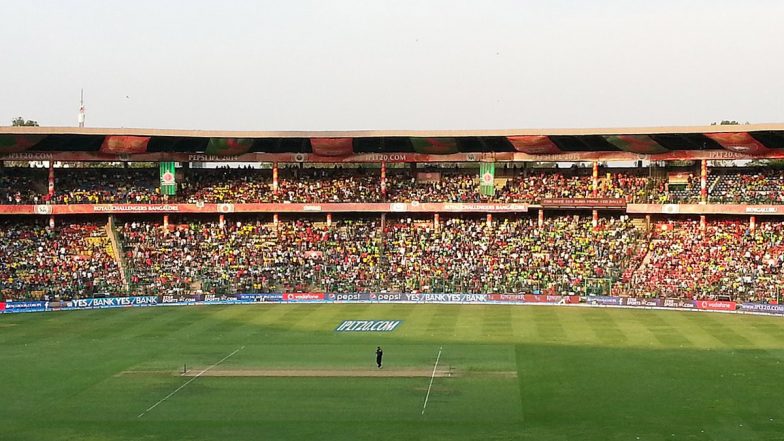The company not only has to hone its tyres for cars that each year generate more load and produce faster lap times, but it also has to prepare for and adapt to any upcoming rule changes.
Last year for example Pirelli had a focus on developing tyres to run without blankets in 2024, only for the planned change to be abandoned.
And that in turn has had a major impact on this season. Usually Pirelli uses its testing programme to develop new tyres with the goal that they will be able to deal with the expected increase in downforce over the course of the season.
Inevitably that means that the teams then undergo a period of learning and adaptation with the latest constructions and compounds.
However that didn’t happen in 2024, as the tyres used this season are identical to those in play at the end of last year.
The previous occasion when such a scenario played out was in 2020-’21, when the COVID pandemic meant that there was no opportunity for tyre development, and it was agreed that the same tyres would be used for a second year.
Mario Isola, Racing Manager, Pirelli Motorsport
Foto di: Steven Tee / Motorsport Images
This time around there were two main reasons why the tyres were unchanged between seasons.
Firstly as noted the focus of testing during 2023 was on developing tyres to run without blankets, rather than specifically on dealing with increasing loads, as is usually the main aim for testing.
However, in the summer it was decided to keep blankets for 2024, and at that stage it was too late to embark on full programme of testing for “standard” blanket tyres.
And secondly a new construction that was already in the pipeline for 2024 was fast-tracked and introduced at Silverstone in July.
It worked well, and the consensus was that it would remain effective for a season and a half, all the way to the final race of this year in Abu Dhabi.
“Usually it’s not a decision that we take, because we try to follow the development of the cars,” says Pirelli motorsport boss Mario Isola of the carryover tyres. “And obviously we update our construction in line with the development.
“But last year we introduced the new construction in Silverstone. The new construction was mainly what we were planning to introduce in 2024 anyway, and that’s why we decided to keep the same construction for 2024.
“The other point is about compounds. Last year we focussed our development campaign on no-blanket tyres, and then there was the decision of keeping the blankets for 2024-25. And at that point, we had to confirm the compounds used in 2023.”

Mario Isola, Racing Manager, Pirelli Motorsport
Foto di: Zak Mauger / Motorsport Images
Keeping the same tyres into a second season had a huge impact on the teams. It meant that they were a known constant that engineers didn’t have to worry about as they developed and then tested their new cars.
“The teams have better knowledge,” says Isola. “We know that there is a learning curve every year. And this year, obviously this learning curve is not going to happen, because the tyres are the same.
“We saw also quite big differences in tyre choices for the Bahrain test. They had in mind that they wanted to focus on a specific compound, for a specific type of development, and so on.
“This is something that doesn’t happen, for example, when we have a completely new product.
“If you have a completely new range of compounds, a certain amount of each compound or set of each compound is chosen by the teams, because they want to understand how each compound is working. This didn’t happen in Bahrain.”
Isola remains confident that the 2023-spec tyres will be able to cope with increasing loads that the cars will produce over this season.
“What we saw last year is that we had a big step in load on the tyres in the first races of the season,” he says. “And according to the simulations we got from the teams for 2024 this curve is going to be not flat, but less steep.
“That means that we have margin to keep the construction for 18 months. Obviously, we are developing a new construction for next year. And if for any reason the development is much higher than expected, we have a back-up plan.”

Gomme Pirelli
Foto di: Steven Tee / Motorsport Images
Pirelli also has the option to adjust pressures after the first day of running at each venue, something that it has done regularly over the years.
“For example in Jeddah we realised that the level of load on the front tyre was higher than expected, and we had to react,” says Isola.
“Now if we raise 1psi, it’s not an issue, because it’s a small adjustment. But if this rate of development will continue for another 10 races or so, then we have to take a decision.”
With the no-blanket dropped – at least for the foreseeable future – Pirelli is focussing its current test programme on creating new tyres for 2025, the last season of the current F1 rules.
“Obviously now we have a different situation, because we have a bit more stability in the regulation for this year and next year,” says Isola. “So for next year we are going to
develop a new family of compounds with a target to reduce overheating. And obviously also a new construction, in order to keep up with the development of the cars.
“We are not planning to introduce anything this year. The plan was to introduce a new intermediate tyre able to work without blankets, but unfortunately at the first two sessions that we planned in Jerez and Barcelona due to dry conditions in Spain in general the government decided to forbid any usage of water to wet the track.
“So we had to convert to a dry test. That was not planned, so now we are looking for new opportunities for wet weather tests.

Valtteri Bottas, Kick Sauber C44, test Pirelli a Suzuka
Foto di: Pirelli
Arranging wet weather testing is not always straightforward, as the two tracks that have sprinkler systems are not fully representative. At other venues the only option is to use tankers to soak the track, but it’s not ideal.
“We have the possibility to test in Paul Ricard and Fiorano,” says Isola. “But they are both low-severity circuits. And if we test and develop there the risk is that if we go to Spa or Silverstone, circuits where it’s raining quite often, then we have a tyre with a level of performance that is not in line with our expectations, because the blocks of the tread pattern tare moving.
“And moving blocks means that you overheat the tyre, you lose grip, and so on and so on. So to produce a tyre with the right level of performance and crossover with the intermediate, we need to test on a high-severity circuit.
“And at high-severity circuits we need tankers to wet the circuit, as they don’t have sprinklers. We cannot wait for rain to come, we cannot ask a team, ‘Stay there and wait, one day it will rain!’ And finding consistent conditions with water tankers wetting the track is not easy.”
The plan to introduced no-blanket dry tyres may have been abandoned but Isola insists that last year’s testing programme wasn’t wasted, as it produced some useful results. The lessons learned are feeding into future tyres.
“It was an interesting exercise on the compounds,” he says. “In fact, one of the ideas that we are developing for next year is coming from a C3 compound that we developed last year for the no-blanket tyres.
“The C3 is in the centre of the range, so from C3 then you can start working on the hard side and soft side. But the C3 is the reference.
“The target was to extend the working range as much as we can, but starting from cold. That means that we had overheating at a certain point, because starting from cold, you have a lower temperature from cold to running, and to stabilise that is huge.
“But we found a compound with a wider working range. And now we are working on the same concept of compound, moving the working range higher, because we have the blankets. So instead of starting from cold, we can start from 70degC.
“We have a compound that is able to work in a wider working range. That means that what we did last year was not useless. Now we have to develop a different concept, and we have two main directions of development, but it’s something we can use.”

Test Pirelli a Barcellona, Charles Leclerc
Foto di: Pirelli
All 10 teams participate in the tyre testing programme with their current cars, taking turns to help Pirelli with sessions usually fitted after race weekends. However with 24 events on the schedule it’s not easy to find dates that work.
“We are obliged to follow the calendar, and to use any opportunity that is coming from the calendar,” says Isola.
“Obviously, when we have a back-to-back event, we cannot stay at the track to test our tyres on Tuesday and Wednesday, and we cannot test them before the race, because obviously it would be a big advantage to the team that is going to test! And so we are always trying to find the best compromise.”
Meanwhile the company already has an eye on 2026, when new chassis and power unit regulations will be introduced, and the tyres will also change. There was an option to change to 16-inch tyres, but Pirelli wanted to stay with 18-inch format for marketing, technical and logistical reasons.
After some debate it has been decided that the current rim size will stay after all, although the precise shape of the tyres has yet to be finalised.
In 2025 Pirelli and the teams will join forces for a test programme geared to preparing tyres for a new generation of cars, similar to that undertaken before the switch to 18-inches in 2022.

Pneumatici Pirelli dentro le termocoperte
Foto di: Steven Tee / Motorsport Images
“For 2026 is probably slightly different because we need to use mule cars,” says Isola. “And it depends on how the teams are planning to build these mule cars. If they use cars from previous championships, they have more flexibility, and we are not obliged to follow the calendar. But at the moment, this is still a discussion.”
The complication for Pirelli is that with the rules yet to be finalised, and teams not allowed to undertake aero work until January, it’s very hard to assess what sort of loads the tyres will be subject to in 2026.
“The teams cannot work around the aero package until beginning of 2025,” says Isola. “But we have to start developing a vehicle model of the tyre, and start developing a physical prototype that we can test indoors.
“The first step for us is to assess the integrity of the tyre, the reliability of the tyre. So we need that information to start working around the new size, with a performance that is estimated. We don’t have the real performance of the car, but at least we can have something to work with.”
Whatever direction the definitive rules take for 2026 Pirelli still has one overriding target – to create a tyre that is good for racing.
“If drivers don’t complain, it’s always better for us!,” jokes Isola. “This is what we are trying to do, to supply a tyre that is a good tyre for the drivers. Good means that they like the tyres.
“Obviously, then we all have to accept a compromise, because if we want a two-stop strategy, we need to generate quite a high level of degradation, otherwise, there is no reason to stop twice. And we know that drivers don’t like a lot of degradation, but with a consistent tyre with no degradation, then we have a one-stop race.
“For spectators, that’s not ideal. It’s better for drivers, but probably not for the sport. So we need always to find the best compromise – and sometimes, it’s not easy.”

Mario Isola, Racing Manager, Pirelli Motorsport
Foto di: Mark Sutton / Motorsport Images







